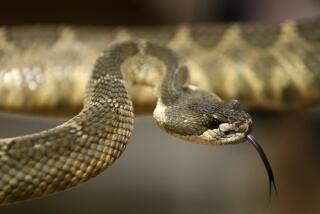As rattlesnake season heats up, sightings on the rise
- Share via
Peak rattlesnake season is fast approaching, and the county’s Department of Animal Services has been busy this year responding to phone calls from residents seeking to remove the venomous serpents from Otay Mesa all the way to Fallbrook.
The department’s officers have answered more than 275 rattlesnake-related calls since January, a roughly 40 percent increase over the same period last year. With rattlesnake sightings typically peaking during the hot and dry summer months, Animal Services routinely receives more than 1,000 calls a year.
On Tuesday, a 66-year-old man was flown to a trauma center after being bit on both of his index fingers outside his home in Ocotillo Wells. He was having trouble breathing and fell unconscious when the medics arrived. As of 1:15 p.m., no update had been given on his condition.
Rattlesnake populations fluctuate based largely on rises and dips in rodent populations, which is a main source of food for the reptiles.
“If someone calls and says there’s a snake in our backyard, we notify an officer and it’s one of our highest priorities,” said Daniel DeSousa, director of county Animal Services. “They have the training and equipment to grab the snake and put it in the bucket and put it somewhere in the community that’s safe for the snake and the residents.”
More than 155 rattlesnakes have been removed by the county from homes and public spaces this year. The San Diego Humane Society handles animal control for the cities of Oceanside, Vista, San Marcos, Escondido and Poway.
Sightings were most concentrated in areas north of Interstate 8. People in the region surrounding Rancho Peñasquitos and the Black Mountain Open Space Park have logged the most calls this year — nearly two dozen.
Residents should report only rattlesnakes that are in homes or populated areas, DeSousa said. The reptiles should never be disturbed if found in canyons or the backcountry.
When identifying the poisonous snakes, it’s important to remember they can lose their rattles over time. Often confused with gopher snakes, rattlesnakes have wide triangular heads and thin necks.
In San Diego County, rattlesnakes are the only venomous snakes. In the coastal and mountain areas, the types of such snakes include the Western, Southwestern Speckled and Red Diamond. The Colorado Desert Sidewinder is found in the county’s desert region.
While dangerous to humans, these snakes are important for the county’s ecology, said Bradford Hollingsworth, biologist and curator of herpetology with the San Diego Natural History Museum.
“Rattlesnakes are critical components of our ecosystem,” he said. “Their persecution would only lead to ecological problems. They control our rodent populations and keep them in check.”
Victims of rattlesnake bites should seek immediate medical attention at an emergency room. Tourniquets are highly discouraged, as is the use of ice or a cold compress.
Rattlesnake bites cause painful swelling, bleeding and bruising, but are rarely fatal, according to the California Poison Control System. Those most at risk for potentially deadly impacts are children and pets.
Bite prevention measures include wearing boots and long pants when hiking and inspecting logs and rocks before sitting in the backcountry. The snakes should never be disturbed, even if thought dead or sleeping.
The state receives about 300 calls a year reporting bites, most frequently between April and October. The highest number of bites frequently happens in May.
Twitter: @jemersmith
Phone: (619) 293-2234
Email: [email protected]
More to Read
Sign up for Essential California
The most important California stories and recommendations in your inbox every morning.
You may occasionally receive promotional content from the Los Angeles Times.











